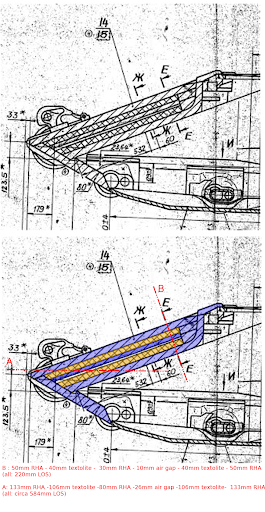I doubt that basic hull was made from alluminium, it have no sense and make vehicle vurnable to fire.
The whole vehicle shell was made of Aluminium. The British army tested a number of different vehicles with all Aluminium hulls and turrets for reducing the combat weight (it seems that the British had some more advanced techniques for welding very thick Aluminium plates). The FV4211 "Aluminium Chieftain" is probably the vehicle closest to the projected Chieftain Mk 5/2 and has both the hull and the turret shell made of Aluminium. The so called Jagd-Chieftain prototype with mock-up gun developed during the Anglo-German cooperation also had a hull completely made of Aluminium. The Valiant MBT prototype also had a full Aluminium construction.
Zaloga changed his estimations many times. My conclusion differs from yours, deal with this.

Haven't seen him changing his estimates a single time.
Do you trully believe that GDLS and US Army would reveal to Zaloga true protection levels of their tank that are classified?

I think that GDLS and the Army does provide the same statements as the British MoD/Vickers or the German MoD/KMW. In German literature it is cleary said that the protection requirement for the Leopard 2 was surviving 125 mm APFSDS at long/medium ranges (written by P.-W. Krapke, who happened to work on the Leopard 2 programme) or that the MBT-70 was designed with protection against 105 mm APDS at 800 m ranges or greater (as written by Spielberger).
Similiar statements about the protection requirements can be found in many other books... Zaloga also writes about protection requirement of the Abrams vs 115 mm APFSDS - do you think that Zaloga is bad/dumb and makes this statement based on the old TACOM programme alone? There is no proof that he didn't get this information from the Army or GDLS. In fact even the Army's own magazine writes about protection against 115 mm APFSDS in an article about the history of the Abrams tank

Steven J. Zaloga M1 Abrams Main Battle Tank 1982-1992 published 1993, at page 9-10 he wrotes 350mm RHAe vs KE and 700mm RHAe vs CE for basic variant of the M1.
Steven J. Zaloga M1 Abrams vs T-72 Ural published 2009, at page 15 the same author wrotes 470mm RHAe vs KE and 650mm RHAe vs CE for the same basic variant of the M1.
No. In his later book he writes about Soviet estimates and not his own ones. He writes that a Soviet report estimated the M1 to have a protection level of 470 mm RHAe vs KE and 650 mm RHAe vs HEAT, while the M1A1 was believed to have 600 mm RHAe vs KE and 700 mm RHAe vs HEAT protection. The question is however how accurate the Soviet report is. Soviet composite armour has always been of a considerable different desgin - their armour had very high density due to the use of extremely thick cast steel layers (about 400+ mm in most cases), which is why their estimations must not be accurate for Western MBTs (with bulky armour consisting of many lightweight elements). Zaloga however writes in the same book twice that the M1 Abrams was designed with protection requirements against 115 mm APFSDS (105 mm APFSDS was used as reference) and that this was essentially the same protection requirement as the T-72 had.
Zaloga writes also in his book about the T-55, that a T-55 with BDD (brow) armour has with 380 mm RHAe vs KE about equivalent protection as the earliest M1 Abrams.
So not only Zaloga is not credible, but also you are loosing your credibility by not only not knowing this niuanse, but also quoting author who changes his mind over the years.
You just didn't pay attention reading his writings.
Don't try to tell me what means what. Arrangement can mean anything, did you ever had any closer ties to military and actually knows that military likes to call many things in a very enigmatic thing?
I disagree with you.
Yes, I had closer ties to the military. And about the arrangement term we seem to disagree. I don't really see why you need to do that, given that Hunnicutt provides a number of examples where the location/thickness of the armour was changed and how this is the more logical given that the meaning "changed the arrangement/composition of the armour itself" requires more specification to be meant.















